Rice is a grass, much like wheat and barley. So why is it grown in flooded fields (known as paddy fields)?

Based on carbon dating of grains and the soil the grain was found in, paddy fields date to 4300 BC in China (the chemical signature of flooded soil is present). Other similarly ancient paddy fields have been found in Korea and Indonesia and India.
Typically, flat terraces are cut into hills with low walls on the outer edge of the terrace to trap rain water. The field is then planted and flooded. In places with monsoon rains, they wait for nature to do the flooding, and trap the water with mud dykes.
Yet we know that rice doesn't need flooded fields to grow. So why use (and perhaps waste) so much water?
The answer is surprising - the water acts like a weedkiller. Unusually, rice can cope with being flooded, but most weeds cannot. So ancient people simply flooded the fields to save on the task of having to go up and down each week and pull out weeds. The water additionally means that the rice plant has all the liquid it needs to grow. To prevent mosquitos laying their eggs in the still water, fish are often added to the paddy. (The movement of the fish as they swim about makes the water unsuitable for mosquito eggs, and the fish faeces add fertiliser to the paddy).
Some environmentalists advocate draining the fields because they claim the water encourages methane production (as the dead weeds decay). But they haven't answered the question about what to do with the weeds. Rice is an organically grown plant precisely because it doesn't need weedkillers and fertiliser, thanks to growing it in flooded fields.